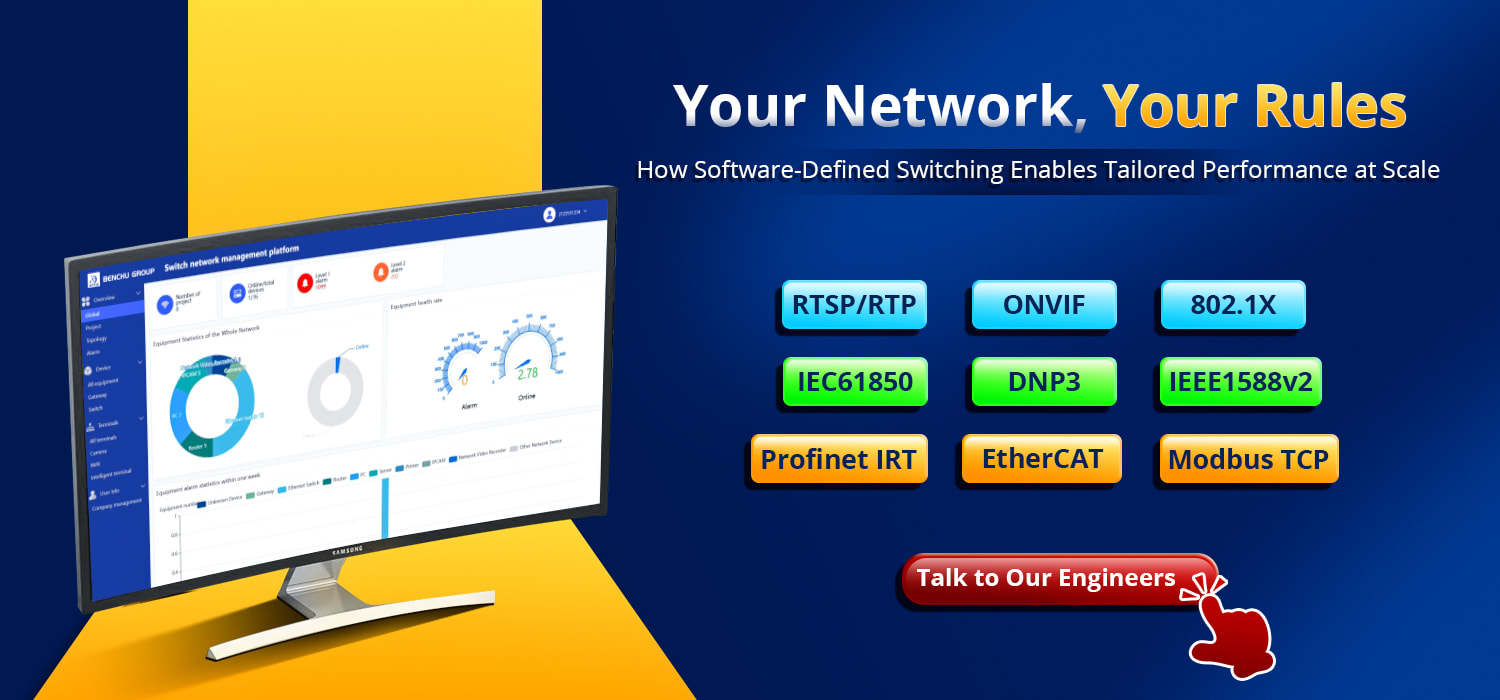Software/Cloud Customization

Software Protocol Customization
Tailored Protocol Stacks for Deterministic Industrial Networks – From IEEE 1588v2 to PROFINET IRT

Security (Video Surveillance/Access Control)
Use Cases
• Prioritized video streaming (low latency/packet loss)
• Dynamic VLAN assignment for access control systems
• Tamper-proof logging
Key Protocols & Customizations
| Protocol | Customization Focus | Implementation Example |
| RTSP/RTP | Dynamic QoS adjustment for emergency events | OpenFlow-based traffic policy injection |
| ONVIF | Whitelisted device discovery | Deep Packet Inspection (DPI) + MAC filtering |
| 802.1X | MAC-VLAN binding via RADIUS attributes | Python scripts interfacing with FreeRADIUS |
Case
"A customized RTP stack reduced video latency from 120ms to 40ms for H.265 traffic in airport surveillance systems."

Power Utilities (Smart Grid/Substations)
Critical Needs
• IEEE 1588 precision timing for grid synchronization
• SCADA encryption (anti-eavesdropping)
• Storm control (BPDU/GOOSE flood mitigation)
Protocol Tailoring
| Protocol | Custom Action | Tech Approach |
| IEC 61850 | GOOSE/SV priority mapping to DSCP | P4-programmable ASIC packet rewriting |
| DNP3 | Filtering by function codes (e.g., block "write" commands) | eBPF/XDP firewall hooks |
| IEEE 1588v2 | Temperature-compensated clock offset | FPGA-based servo control algorithm |
Result
“A wind farm’s DNP3 protocol stack modification blocked 90% of unauthorized control commands.”

Industrial Automation (PLC/Robotics)
Requirements
• μs-level deterministic communication
• Legacy equipment support (Modbus RTU over TCP)
• Redundancy (HSR/PRP)
Custom Protocol Engineering
| Protocol | Enhancement | Method |
| Profinet IRT | Jitter reduction (1μs → 500ns) | TAS (Time-Aware Shaper) configuration |
| EtherCAT | Selective slave diagnostics skip | Modified ESC (EtherCAT Slave Controller) firmware |
| Modbus TCP | Anti-replay via HMAC-SHA256 | TCP payload injection via kernel module |
Outcome
“Automotive plants achieved ±0.1mm robotic precision via Profinet IRT optimizations.”

Converged IT/OT Networks
Shared Needs
• Vendor-agnostic interoperability
• Application-aware telemetry
• Zero-trust segmentation
Generic Protocol Modifications
| Protocol | Goal | Solution |
| LLDP | Custom TLV for environmental sensors | Linux kernel LLDPd patch |
| sFlow | Embedded app-layer metadata (e.g., OPC UA) | Switch SDK flow sampling hooks |
| TLS 1.3 | SM2/SM4 support for Chinese regulations | OpenSSL engine + hardware offload |
Applicable Scenarios: Process industries (petrochemicals/pharmaceuticals), discrete manufacturing (automotive/semiconductors), and other fields requiring "last-mile" data integration.
Software Customization and Implementation Process
Proven Framework for Industrial-Grade Customization – From Concept to Seamless Deployment
1. Initial Consultation & Requirements Gathering
Goal: Understand your needs and validate feasibility.
| Step | Action | Deliverables |
| 1.1 |
Discovery call/video meeting to discuss: - Use case (e.g., video surveillance latency optimization) - Protocols involved (e.g., RTP, ONVIF, IEC 61850) - Constraints (latency, compliance, legacy systems) |
Output: Requirements Specification Document (RSD) |
| 1.2 |
Technical deep-dive workshop (optional): - Analyze network topology & traffic patterns - Identify hardware/software dependencies |
Output: Technical Feasibility Report |
Client Input Needed: Share existing network diagrams, protocol specs, or test logs.
2. Proposal & Prototyping
Goal: Define scope, costs, and validate concepts.
| Step | Action | Deliverables |
| 2.1 |
Submit a formal proposal including: - Customization roadmap (phases/timeline) - Cost breakdown (development, testing, support) - Success metrics (e.g., "Profinet IRT jitter < 500ns")
|
Output: Statement of Work (SoW) |
| 2.2 |
Develop a proof-of-concept (PoC): - Simulate key features (e.g., QoS for video streams) - Test in a lab environment (we provide or use yours) |
Output: PoC Demo + Performance Report |
Client Input Needed:
• Approve SoW/PoC scope.
• Provide sample traffic/data if applicable.
3. Development & Testing
Goal: Build and rigorously validate the solution.
| Phase | Activities | Tools/Methods |
| 3.1 Development |
- Custom protocol stack coding (C/P4/FPGA) - API/module integration (e.g., RADIUS for 802.1X) |
Git, CI/CD pipelines, HW emulators |
| 3.2 Testing |
- Functional tests (unit/integration) - Performance benchmarks (latency/throughput) - Security audits (fuzzing, pen tests) |
Wireshark, Ixia, Spirent, Metasploit |
Transparency Measures:
• Weekly build updates via GitHub/Jira.
• Shared test reports (e.g., "DNP3 filtering: 99.9% block rate").
4. Deployment & Validation
Goal: Smooth rollout with measurable outcomes.
| Step | Action | Client Role |
| 4.1 Staged Deployment |
- Pilot launch in non-critical environment - Monitor for anomalies (e.g., packet drops) |
Provide testbed access |
| 4.2 Live Deployment |
- Full-scale rollout with fallback plan - On-site/remote support during cutover |
Approve go-live checklist |
Success Criteria: All KPIs met (e.g., "GOOSE message delay < 2ms").
5. Support & Continuous Improvement
Goal: Ensure long-term reliability and adaptability.
| Support Tier | Coverage | Examples |
| Gold (24/7) | Emergency patches, SLAs for critical fixes | Power grid failover support |
| Standard | Business-hours support, quarterly updates | Protocol extensions per new standards |
Optional Extensions:
• Training sessions for your IT/OT teams.
• Annual roadmap reviews for future needs.
Why Partner With Benchu Group?
 Proven Expertise
Proven Expertise
 End-to-End Ownership
End-to-End Ownership
 Transparent Workflow
Transparent Workflow
Next Steps: Talk to our engineer +86 0755 23246531
FAQ Response
Q: "Does customization void vendor support?"
A: "Our containerized protocol modules operate alongside certified stacks, preserving warranties.